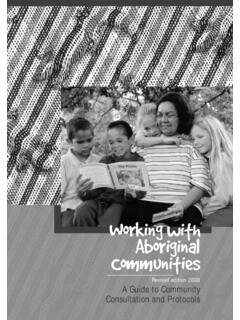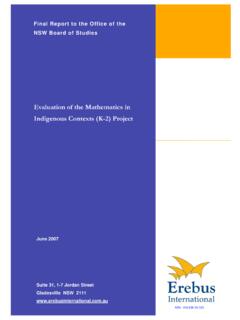Transcription of Mapping Aboriginal Perspectives and Cross-curriculum ...
1 Mapping Aboriginal Perspectives and Cross-curriculum Content K 10 2009 Section A ..3 K 6 Advice to Teachers ..3 K 6 Foundation K 6 Syllabuses ..7 Early Stage 1 and Stage Stage 2 ..9 Stage 3 ..12 Section Syllabus Support Materials K Section Years 7 10 Section D ..29 Syllabus Support Materials Years 7 10 ..29 All page references in this document refer to print copies of web versions of syllabuses and support materials. Contents 2 Mapping Aboriginal Perspectives and Cross-curriculum Content K 10 Section A K 6 Advice to Teachers Syllabus or support document Advice on: English K 6 Meeting the Needs of All Language Learners Modules Aboriginal and Torres Strait Islander Students (pp 9 11) Aboriginal English Strategies for Inclusive Teaching Otitis Media and its Impact on Learning Teaching Strategies for Students with Otitis Media Teaching English: Early Stage 1 Home/School Language: Encouraging home language use in the classroom is an important means of showing acceptance of students home background language, culture and ethnicity.
2 Home languages include languages other than English, as well as varieties and dialects of English, including Aboriginal English. Strategies to build home language experiences are included. (p 23) PDHPE K 6 Modules Meeting the Needs of All PDHPE Learners (pp 7 9) Aboriginal and Torres Strait Islander Students Otitis Media and its Impact on Learning Science and Assessment and evaluation: Technology Whatever assessment strategies are used, it is important that teachers ensure that K 6 Syllabus tasks are accessible to all students. The language used needs to be suitable for all students including those from non-English speaking backgrounds, and activities should not disadvantage students from Aboriginal backgrounds. (p 28) Science and Learning and teaching in science and technology Technology Aboriginal students (pp 40 43) K 6 Support The learner group Document Aboriginal identity and self-esteem Recognising Aboriginal students cultural attributes and needs School/community consultation Aboriginal science and technology The learning environment Teaching practices Creative Arts Rationale: K 6 Syllabus The artforms of visual arts, music, drama and dance can be thought about in a variety of ways.
3 Through the arts, the diverse and pluralistic values of Australian cultures, including those of Aboriginal and Torres Strait Islander peoples, reflect the interests and aspirations of groups, and their identities. (p 6) The inclusion of Perspectives in the Creative Arts: Australian examples should be considered in teachers planning and programming and should refer, where appropriate, to particular artists, actors, musicians, dancers and events of significance in cultural life. 3 Mapping Aboriginal Perspectives and Cross-curriculum Content K 10 Syllabus or support document Advice on: In their planning and programming, teachers should take into account issues related to Aboriginal and Torres Strait Islander peoples. Teachers should note that experiences in the arts of Aboriginal peoples contribute to students understanding of Australian society and to the reconciliation of Indigenous and non-Indigenous Australians.
4 Contemporary practices of Aboriginal and Torres Strait Islander peoples in the arts reflect ongoing traditions. It is recommended that from Early Stage 1 to Stage 3 all students should experience the work of Aboriginal and Torres Strait Islander peoples. Teachers need to remember that they are facilitators of the passing on of traditional knowledge and that Elders are the keepers of this traditional knowledge, art and culture. Aboriginal families and communities should be involved in contributing to this important perspective of the curriculum . (p 9) Visual Arts (Appreciating): Students should be exposed to a wide range of artists, artworks and artistic practices in Australian cultures. These include Aboriginal and Torres Strait Islander peoples where the visual arts are integral to the expression of Aboriginal cultural identity and contemporary interpretations of experience.
5 (p 11) Drama (Performing): Students should be given opportunities to perform and appreciate a variety of drama forms from different Australian cultures including those of Aboriginal and Torres Strait Islander peoples where ceremony and performance are integral to the expression of their cultural identity. (p 15) Dance (Appreciating): Ideas for dance can be drawn from the following cultural traditions, contemporary and historical contexts: contemporary and popular dance in Australia social dances from local and wider sources, including diverse cultures in Australia modern dance of the 20th century Aboriginal and Torres Strait Islander traditional and contemporary dance indigenous, folk and traditional dances of the world. (p 17) Values and Attitudes in the Creative Arts: Teachers and students can: recognise that experiences in the arts of Aboriginal peoples contribute to students understanding of Australian society and to the reconciliation of Indigenous and non-Indigenous Australians (p 18) Visual Arts (Subject Matter): Designs, symbols and motifs of animals, birds and reptiles in Aboriginal art and micro and macro views of other living things provide other sources for ideas for artworks.
6 (pp 80 81) 4 Mapping Aboriginal Perspectives and Cross-curriculum Content K 10 Syllabus or support document Advice on: Events of historical, cultural, religious and personal significance that affect concepts of identity within Australia can also be explored (eg colonisation, National Aboriginal and Torres Strait Islander Week, also known as National Aboriginal and Islander Day Of Celebration Week (NAIDOC Week), journeys of explorers, dispossession and reconciliation, Australia Day celebrations). Each of these events, and others, can be interpreted in a variety of ways. (pp 81 82) Music (Repertoire [vocal music, instrumental music, student compositions and movement]): A broad range of repertoire from various times, places and cultures provides students with the variety of musical experiences that enable them to develop self-expression, a sense of personal and cultural identity, an understanding of the world around them and an understanding of musical concepts.
7 This should include Aboriginal and Torres Strait Islander music, and music from various times and cultures. Traditional art music repertoire (the classics ) can be used effectively at all stages of students development. Through this exposure to a range of repertoire from around the world, students learn to recognise the importance of music in the world and how music has been used. Repertoire could be drawn from Aboriginal and Torres Strait Islander traditional and popular music, classical music from various traditions and eras, folk music from various traditions, contemporary popular music, world music (incorporating multicultural and popular characteristics) and music by and for children (nursery rhymes, children s playground games and songs composed for children). (p 87) Learning experiences with songs could include: listening to and singing songs from Aboriginal and Torres Strait Islander communities and reflecting on their purposes (p 88) Dance (Contexts): Consideration should be given to providing students with opportunities to experience dance ideas from culturally diverse sources, times and places, including contemporary, personal, community, Australian and global identities.
8 It is recommended that all students experience Aboriginal and Torres Strait Islander dance in some form during K 6. Dance is integral to the expression of Aboriginal cultural identity. (p 96) 5 Mapping Aboriginal Perspectives and Cross-curriculum Content K 10 K 6 Foundation Statements ES1 Students examine characteristics common to people, including Aboriginal peoples, describing some of the similarities and differences. They acquire information by direct observation, talking to others, and by viewing, reading and listening to texts. S1 Students explore the composition of a number of groups, including Aboriginal peoples, in their community and recognise that groups have specific identifying features, customs, practices, symbols, religion, language and traditions. They acquire information about their local community by direct and indirect experience and communicate with others using various forms of electronic media.
9 S1 Students make comparisons between natural, heritage and built features of the local area and examine the human interaction with these features. They investigate the relationship between people and environments including the relationship between Aboriginal peoples and the land. Students use the language of location in relative terms and construct and use pictorial maps and models of familiar areas. S2 Students explore change in communities from different Perspectives and evaluate the effects of change on individuals and groups, including Aboriginal peoples, and the environment. They understand key events related to the British colonisation of Australia and identify the changes and consequences for Aboriginal and other peoples and the continent. S3 Students explain how shared culture, heritage and language, including those of Aboriginal peoples, contribute to Australian and community identity.
10 They explore cultural diversity by examining how cultures change through interactions with other cultures and the environment. 6 Mapping Aboriginal Perspectives and Cross-curriculum Content K 10 K 6 Syllabuses Early Stage 1 and Stage 1 Syllabus Content HSIE K 6 Syllabus Change and Continuity Outcomes and Indicators Significant Events and People (p 22): CCES1 Describes events or retells stories that demonstrate their own heritage and the heritage of others: -listens to and talks about stories of other families and their heritage, including countries of origin and Aboriginality Communicates the importance of past and present people, days and events in their life, in the lives of family and community members and in other communities: -retells the original stories associated with traditions of their family and community, including Dreaming stories, religious stories, recounts, narratives -recognises Aboriginal peoples as the first Australians -locates some Aboriginal place names found in the local area and identifies the meanings and origins attached to them Change and Continuity Outcomes and Indicators Time and Change (p 24): Identifies changes and continuities in their own life and in the local community: -gathers information about the Aboriginal peoples that live/lived in their community Cultures Outcomes and Indicators Identities (p 26): CUES1 Communicates some common characteristics that all people share, as well as some of the differences.




